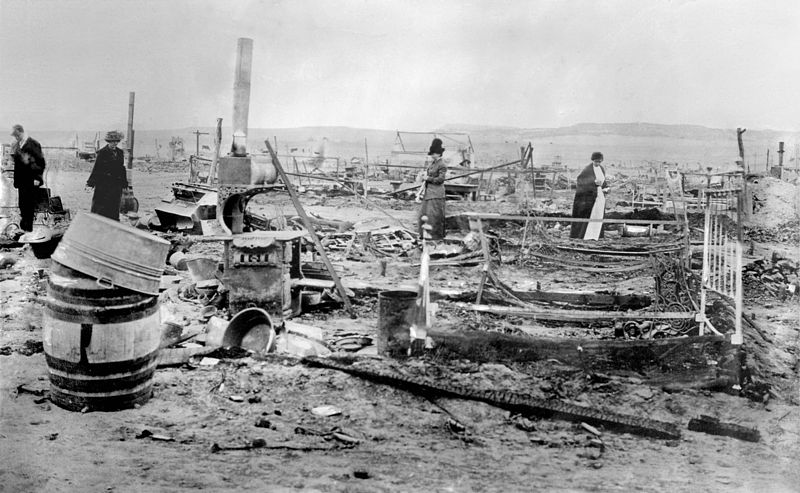War of the Mines

Colorado became a state on August 1, 1876, about nine years after relatively-accessible coal was discovered in the Rocky Mountain regions. By 1910, coal was the driving force of the Colorado economy, with roughly one in ten workers employed by the coal mining industry. Unfortunately, the treatment of coal miners in the state was suspect. The death rate of miners in Colorado was roughly 7 per 1,000 annually, more than twice that of coal miners (“colliers”) elsewhere. Colliers were paid based on the amount of coal they mined, so other work — such as laying tracks for the coal-hauling carts — went unpaid entirely. And in many cases, the towns the coal miners lived in were private ones, owned by the company which employed them. While this allowed for cheaper housing and services, it also meant that the company could kick workers out if need be.
That’s what happened in September of 1913 — and it started a chain of events leading to the desolation pictured above.
In the early part of 1913, many of the coal miners attempted to unionize in an effort to improve working conditions. These efforts, organized by the United Mine Workers of America (UMWA), were focused on employees of the Rockefeller family-owned Colorado Fuel and Iron (CFI), the largest collier employer in the state, and one with some of one of the harshest work conditions. The workers demanded that CFI and other coal mine owners recognize the union, increase wages, pay for an eight-hour day regardless of the amount of coal mined, and enact work safety measures. The companies responded with a resounding no, and the workers went on strike. In response, the companies evicted the workers from their company-owned homes.
The union was prepared for this and had leased land leading up to the coal mines in a town known as Ludlow, Colorado. The union outfitted Ludlow with tents for the displaced workers. The location of the tent city was no accident; the union has specifically chosen that spot to deter replacement workers from going to the mines, as they’d have to pass by the striking laborers to do so, risking potential bodily harm in the process. CFI responded by hiring strike breakers to protect the replacement workers and to take action — physical, not legal action — against the strikers. The two sides took to violent measures so the governor called in the Colorado National Guard.
The National Guard turned a bad situation into a terrible one.
The guardsmen were there to keep the violence at bay, but instead, ended up taking the side of the strike breakers. On April 20, 1914, in an event later known as the Ludlow Massacre, guardsmen flanked by militia members went to the tent city to confront the workers over allegations that the latter were holding a replacement worker prisoner. But instead of a discussion, the two sides took to arms. The guardsmen burned the tent city down and, in doing so, accidentally trapped two women and eleven children in a tent, killing them. All that was left of the Ludlow tent city is what is depicted above.
The tragedy sparked an armed rebellion by miners throughout the state; per Wikipedia, the union provided weapons and ammo to miners and encouraged others to source their own. The collier army, totalling perhaps 1,000 in number, went from mine to mine, attacking guards and burning buildings. The death toll from the tent city destruction and the aftermath totaled at least 75 lives and perhaps as many as 200. It came to an end only when Federal troops, ordered to intervene by President Woodrow Wilson, arrived on the scene and disarmed both sides.
Bonus Fact: The Ludlow Massacre wasn’t the only coal mine-related violence in U.S. history, not by far. There were about a dozen events (typically with less tragic outcomes) across the country during that same era. From August 25, 1921 until September 2nd of that year, to cite one of the worse examples, workers and management/law enforcement clashed in West Virginia, in what is now known as the Battle of Blair Mountain. An estimated 50-100 workers and 10-30 others (on the other side of the fight) lost their lives in the five-day mini-war. Unlike the Ludlow Massacre, though, most of the victims at Blair Mountain were in-combat men.
From the Archives: Underground Coal Fires: In both China and Pennsylvania, there’s coal burning underground — and it has been for decades.
Related: “Blood Passion: The Ludlow Massacre and Class War in the American West” by Scott Martelle. 4.8 stars on four reviews.
